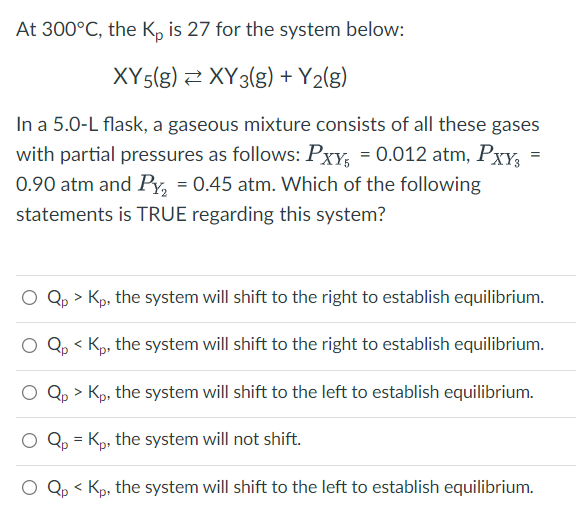At 300°C, the Kp is 27 for the system below: XY5(g) XY 3(g) + Y₂(g) = In a 5.0-L flask, a gaseous mixture consists of all these gases with partial pressures as follows: Pxy₁ = 0.012 atm, PxY3 0.90 atm and Py₂ = 0.45 atm. Which of the following statements is TRUE regarding this system? O Qp > Kp, the system will shift to the right to establish equilibrium. O Qp < Kp, the system will shift to the right to establish equilibrium. Qp > Kp, the system will shift to the left to establish equilibrium. Qp = Kp, the system will not shift. Qp< Kp, the system will shift to the left to establish equilibrium.
At 300°C, the Kp is 27 for the system below: XY5(g) XY 3(g) + Y₂(g) = In a 5.0-L flask, a gaseous mixture consists of all these gases with partial pressures as follows: Pxy₁ = 0.012 atm, PxY3 0.90 atm and Py₂ = 0.45 atm. Which of the following statements is TRUE regarding this system? O Qp > Kp, the system will shift to the right to establish equilibrium. O Qp < Kp, the system will shift to the right to establish equilibrium. Qp > Kp, the system will shift to the left to establish equilibrium. Qp = Kp, the system will not shift. Qp< Kp, the system will shift to the left to establish equilibrium.
Chemistry: Principles and Reactions
8th Edition
ISBN:9781305079373
Author:William L. Masterton, Cecile N. Hurley
Publisher:William L. Masterton, Cecile N. Hurley
Chapter12: Gaseous Chemical Equilibrium
Section: Chapter Questions
Problem 56QAP: Sulfur oxychloride, SO2Cl2, decomposes to sulfur dioxide and chlorine gases. SO2Cl2(g)SO2(g)+Cl2(g)...
Related questions
Question
8. Kindly please provide the answer only ASAP

Transcribed Image Text:At 300°C, the Kp is 27 for the system below:
XY5(g) XY 3(g) + Y₂(g)
=
In a 5.0-L flask, a gaseous mixture consists of all these gases
with partial pressures as follows: Pxy₁ = 0.012 atm, PxY3
0.90 atm and Py₂ = 0.45 atm. Which of the following
statements is TRUE regarding this system?
O Qp > Kp, the system will shift to the right to establish equilibrium.
O Qp
< Kp, the system will shift to the right to establish equilibrium.
Qp > Kp, the system will shift to the left to establish equilibrium.
Qp = Kp, the system will not shift.
Qp<
Kp, the system will shift to the left to establish equilibrium.
Expert Solution
This question has been solved!
Explore an expertly crafted, step-by-step solution for a thorough understanding of key concepts.
Step by step
Solved in 2 steps with 2 images

Knowledge Booster
Learn more about
Need a deep-dive on the concept behind this application? Look no further. Learn more about this topic, chemistry and related others by exploring similar questions and additional content below.Recommended textbooks for you

Chemistry: Principles and Reactions
Chemistry
ISBN:
9781305079373
Author:
William L. Masterton, Cecile N. Hurley
Publisher:
Cengage Learning

Chemistry
Chemistry
ISBN:
9781305957404
Author:
Steven S. Zumdahl, Susan A. Zumdahl, Donald J. DeCoste
Publisher:
Cengage Learning

Chemistry: An Atoms First Approach
Chemistry
ISBN:
9781305079243
Author:
Steven S. Zumdahl, Susan A. Zumdahl
Publisher:
Cengage Learning

Chemistry: Principles and Reactions
Chemistry
ISBN:
9781305079373
Author:
William L. Masterton, Cecile N. Hurley
Publisher:
Cengage Learning

Chemistry
Chemistry
ISBN:
9781305957404
Author:
Steven S. Zumdahl, Susan A. Zumdahl, Donald J. DeCoste
Publisher:
Cengage Learning

Chemistry: An Atoms First Approach
Chemistry
ISBN:
9781305079243
Author:
Steven S. Zumdahl, Susan A. Zumdahl
Publisher:
Cengage Learning


Chemistry & Chemical Reactivity
Chemistry
ISBN:
9781133949640
Author:
John C. Kotz, Paul M. Treichel, John Townsend, David Treichel
Publisher:
Cengage Learning

Chemistry & Chemical Reactivity
Chemistry
ISBN:
9781337399074
Author:
John C. Kotz, Paul M. Treichel, John Townsend, David Treichel
Publisher:
Cengage Learning